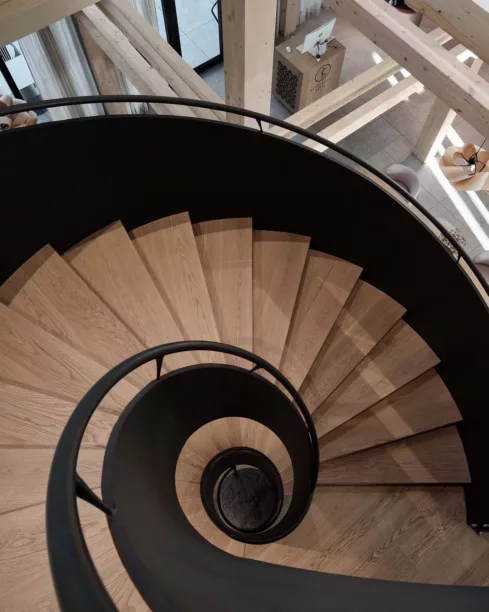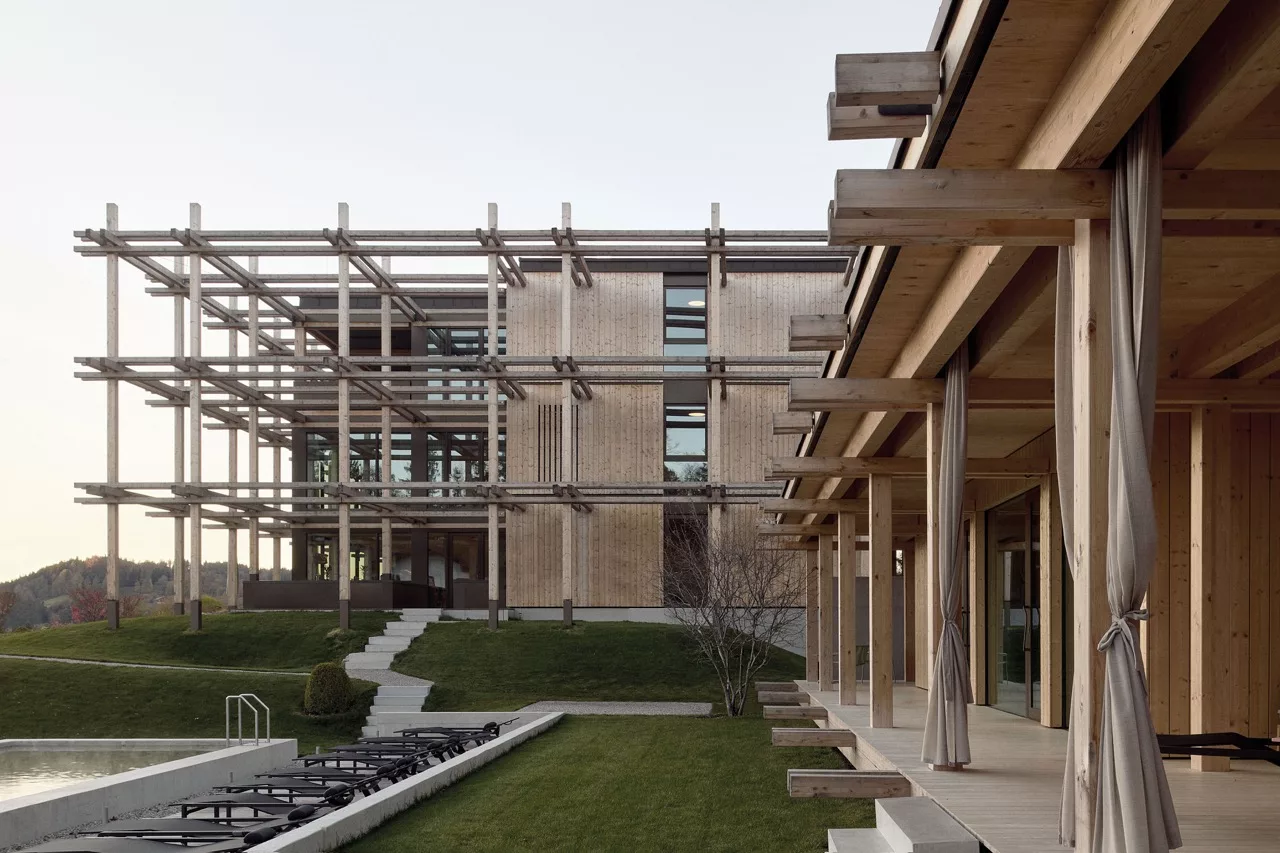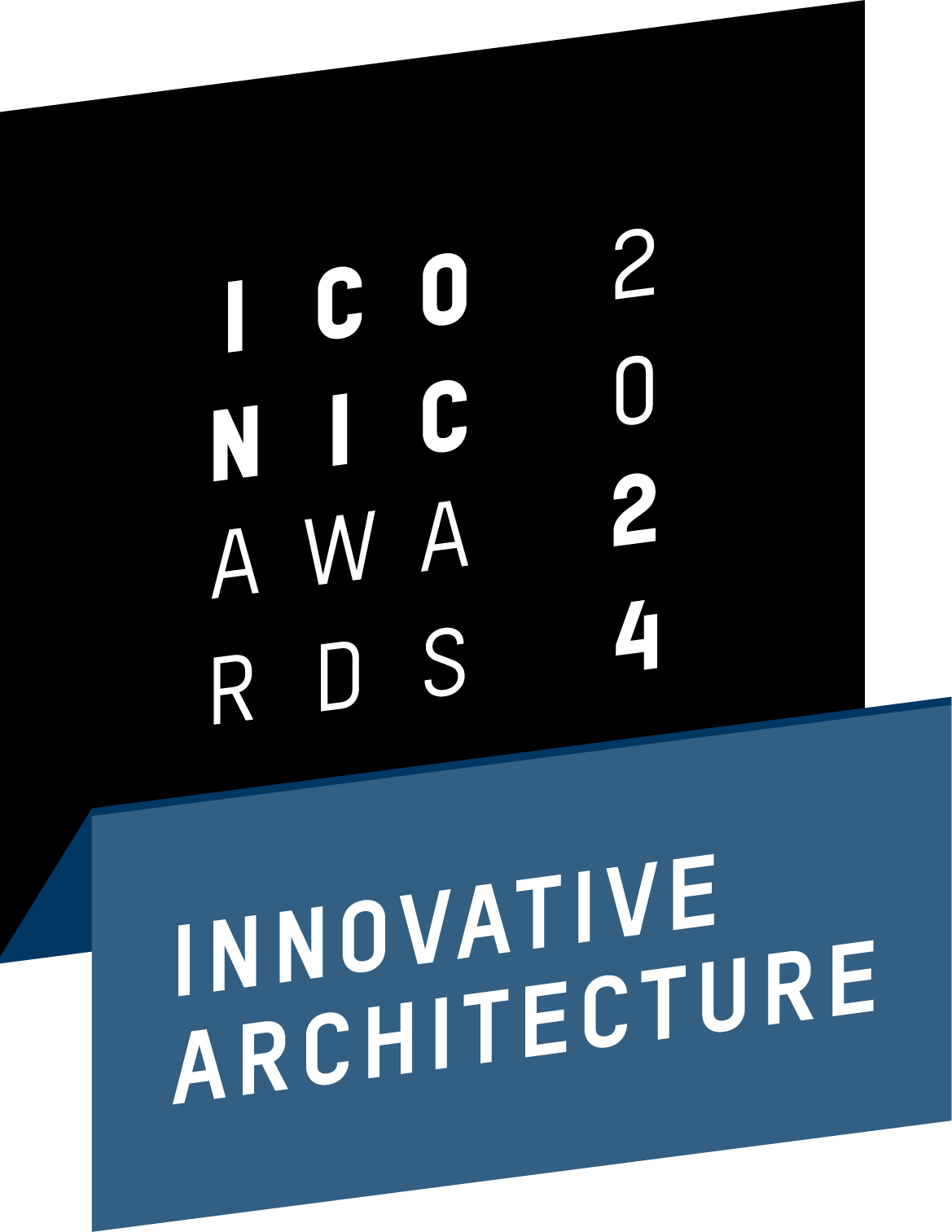Modern timber construction is reinventing itself, driven by innovation and sustainability. In particular, the combination of timber with materials such as concrete is opening up new possibilities. Two winning projects from the ICONIC AWARDS: Innovative Architecture show how experimental building methods are shaping the industry.
By Sofia Wrede

Mass Timber construction is undergoing a renaissance and transformation, driven by technical innovation and an increased focus on sustainability in the construction industry. Timber is increasingly being used in hybrid structures with concrete and other materials to combine the benefits of both. Architects are creatively using renewable timber in both new buildings and renovations in a wide range of projects, from high-rise towers to large educational buildings and rural hospitality developments.
Two projects, both winners of this year’s ICONIC AWARDS: Innovative Architecture, invite viewers to discover exciting parallels in their unconventional approaches to construction and to discuss key differences. A particular highlight will be the innovative materials resulting from the collaborative dialogue between architects and clients.

Timber Frame Inspired by Urban Forest
Situated in the picturesque landscape of the foothills of the Alps and adjacent to an urban forest, the architectural firm Beham, in close collaboration with the client, has created an experimental timber building in Bad Tölz. The hotel’s open frame structure is formed by a grid of vertical and horizontal timber beams, inspired by the structure of the adjacent forest and translated into an open timber skeleton design.
Every material has its strengths and weaknesses – I am not a fan of ideologically driven extreme solutions,’ says Sebastian Beham. For this project, Beham Architekten and the client opted for a hybrid construction combining timber and concrete to maximise the benefits of both, particularly in terms of fire and sound insulation. Concrete floors inside the building reduce noise levels – essential for a hotel dedicated to relaxation. The guest areas are constructed using prefabricated timber frame elements with integral windows and precast concrete slab ceilings, allowing for rapid construction. In the public areas, where noise control and fire protection are less critical, a timber frame structure with cross-laminated timber ceilings is used. The thermally and structurally separated skeleton construction allows for later revision of external elements without thermal bridging.
Focus On Regional Resources
For Sebastian Beham, choosing the right type of wood was crucial, with factors such as cost, transport and sustainability playing a key role. The timber facades were made from local timber by a regional carpenter. Beham Architekten took an unusual approach by choosing spruce, a softwood not known for its durability. The spruce was sliced, its weak points removed and the beams laminated to create a strong structure.
The architects also experimented with the joints between the vertical and horizontal beams, which are normally susceptible to rot due to the exposed end grain. To avoid the usual metal cladding, the firm explored unconventional alternatives. After two years of testing, Beham decided to use a PU coating to protect the end grain from moisture, significantly extending the life of the timber and eliminating the need for energy-intensive metal cladding.
Paving the Way for Experimental Building
This innovative project was made possible by the client’s great trust in the architects. The client signed numerous waivers of liability and accepted that the building would deviate from several German building regulations. Timber construction today is governed by regulations on fire safety, structural stability, sound insulation, building approvals, energy efficiency, moisture protection and material standards – all designed to ensure the safety and sustainability of buildings, but also posing significant technical and bureaucratic challenges.
The growing number of standards, which often hinder experimental and sustainable construction, has been a long-standing issue in the industry. Initiated by the Bavarian Chamber of Architects, Bavaria introduced a new ‘Building Type E’ in 2023 to facilitate experimental construction. The ‘E’ stands for both experimental and easy, allowing architects such as Sebastian Beham and pioneering clients to test new materials and construction methods outside of standard regulations, promoting innovation and sustainability. Hotel Bergeblick is classified as an E building.
Following the example of Bavaria, a nationwide recommendation for Building Type E is being considered. In July 2024, the German Federal Ministry of Housing, Urban Development and Construction (BMWSB) acknowledged that Building Type E is a promising approach: ‘By allowing flexible deviations from public and contractual standards, this approach strengthens the flexibility and freedom of the contracting parties’. Soon, the BMWSB will present ‘Guidelines and Process Recommendations for Building Type E’, which will use selected examples to demonstrate how simple and reduced construction can be legally secured between project participants.
Experimental projects are already possible today, thanks to experienced and willing clients, as a project in the north of the country shows.


Experimental Timber Construction in the North Sea: Piling 2.0
Close to the North Sea in St Peter-Ording, many of the timber buildings commissioned by the local tourist board are exposed to the elements. For over a century, St Peter-Ording’s iconic stilt houses, mostly used as beach bistros, have withstood the forces of nature. Just a few hundred metres away on the promenade, Holzer Kobler Architekturen completed a mixed-use building in 2023, with vertical and horizontal timber beams rising three to five storeys. Viewing platforms and glass facades on different levels offer breathtaking views of the UNESCO-protected salt marshes. From the top floor, a spiral slide winds through the open timber facade of the ‘Experience House’, which includes an indoor playground, restaurant and tourist information.

Vertical Layering With Innovative Timber Matrix
For the Erlebnis-Hus in St. Peter-Ording, Holzer Kobler Architects developed a ‘Piling 2.0’ approach, a vertical layering of functions within a timber matrix into which different volumes are inserted. Like Beham Architects, Holzer Kobler used a timber frame structure combined with a concrete foundation and stair core. The concrete core stabilises the building and reinforces the timber structure, providing additional stability. The foundation can be submerged at high tide, while the building’s public spaces and restaurant start on the first floor. The concrete staircase core also allows for an elevator shaft, making the ‘Experience House’ fully accessible.
The project aimed to create a space for exploration and enjoyment. The timber matrix gives the building a sense of movement and the design incorporates architectural and cultural influences, including metabolist architecture and Yona Friedman’s ‘Spatial City’. The timber structure meanders into its surroundings, creating a sense of interaction and potential for further development.

Unusual Solutions for Extreme Conditions
One of the most important decisions in the design and construction was to manage compliance with DIN standards. Holzer Kobler Architekturen, like Beham, worked with the client to be flexible with the standards. The client, the tourism authority, had extensive experience with timber structures exposed to the elements. Knowing that stainless steel can corrode as quickly as other materials in this environment, they chose cost-effective galvanised steel for the connectors. In addition, although the regulations required the building to be covered to protect the timber from rain, the architects noted that rain falls on all sides here, so a cover would obstruct the view without reducing the exposure. There was also no need for angled features to facilitate water drainage; strong winds dry the structure quickly.
Safety First: Fire Hazard
Siberian larch was chosen for the building because of its durability, while the timber joints were designed to allow airflow and drying. A PU coating, as used in the Hotel Bergeblick, was not feasible due to conditions such as sand, salt and wind. Using unconventional methods, the ‘Experience House’ pushes the boundaries of traditional timber construction. ‘This project has taught us a lot about experimental timber construction,’ says Andrea Zickhardt. It’s certainly not a standard project, but it shows what’s possible if you’re willing to go new ways. Zickhardt emphasises the importance of expert planning in statics and fire safety for such experiments. What’s her opinion about timber construction in Germany? ‘It is unfortunate that fire regulations are becoming stricter and stricter. Countries like Switzerland are much more relaxed and pragmatic’.
Swiss projects such as ‘Francesco’ by Marquez Architects (also a winner of the ICONIC AWARDS: Innovative Architecture) and the country’s first timber high-rise, ‘Suurstoffi 22’, were made possible by new fire regulations. More timber high-rises will be completed in Switzerland in the coming years.
More exciting timber projects recognised at the ICONIC AWARDS 2024: Innovative Architecture:

Share on Social Media

About the ICONIC AWARDS 2024: Innovative Architecture
FUTURE-ORIENTED, HOLISTIC, INNOVATIVE – The internationally renowned award honours holistic projects in the fields of urban and architectural design, interior design, product design and brand communication.

